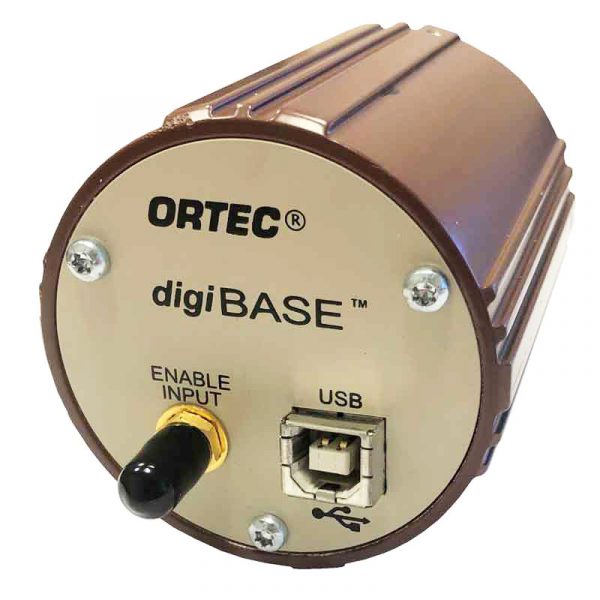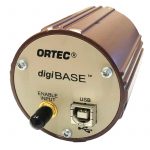Ortec DigiBase
$150
Multi-Channel Analyzer (Field portable)
The digiBASE is a 14 pin photomultiplier tube base for gamma ray spectroscopy applications with NaI(Tl) scintillation detectors. The unique concept of the digiBASE combines a miniaturized preamplifier and detector high voltage (0 to 1200 V bias) with powerful digital signal processing, multichannel analyzer, and special features for fine time resolution measurements.
Weekly Price: $150Monthly Price: $300
- Description
Description
- Full featured digital MCA and gain stabilizer for ultimate stability
- Fast data acquisition for maximum throughput
- The ultimate in Fine Time Resolution with “List Mode”
- Multi-detector arrays made simple with USB Connection
- 0 to +1200-V Detector Bias Voltage
- Includes MAESTRO Advanced MCA software.
The digiBASE is a 14-pin photomultiplier tube base for gamma-ray spectroscopy applications with NaI(Tl) scintillation detectors. The unique concept of the digiBASE combines a miniaturized preamplifier and detector high voltage (0 to +1200 V bias) with powerful digital signal processing, multichannel analyzer, and special features for fine time resolution measurements — all contained in a low-power (<500 mA), lightweight (10 oz, 280 g), small-size (63 mm diameter x 80 mm length) tube base with a USB connection. Everything you need to connect to your NaI(Tl) detector is included in the tube base. Furthermore, there is no need to open your computer to install an interface card, or for using external NIM-based components. The digiBASE includes MAESTRO MCA emulation software and is available with A66SV-BW GammaVision Gamma Spectroscopy for Scintillation Detectors for complete quantitative analysis.
Simple Installation
Installation is simple via the USB interface of the PC. Just load the software, establish communications using ORTEC Connections software and begin making measurements. It’s that simple!
Superb Spectral Stability
NaI(Tl) detectors have a gain that is sensitive to changes in the ambient temperature and magnetic fields. DigiBASE incorporates a gain stabilizer to significantly diminish this sensitivity. It works by monitoring the centroid of a designated peak in the energy spectrum. The fine gain is automatically and continuously adjusted to maintain the centroid of the peak at its desired position. If you are interested in superb gain stability, the digiBASE is your answer!
PERFORMANCE
| Conversion Gain | 1024 channels |
| Coarse Gain | Gain settings of 1, 3 and 9 (controlled by jumper) |
| Fine Gain | 0.4–1.2 |
| Integral Nonlinearity | ≤±0.05% over the top 99% of the range |
| Differential Nonlinearity | ≤±1% over the top 99% of the range |
| Dead Time Accuracy | <5% error up to 50k cps input count rate. Deadtime is measured with a Gedcke-Hale Livetime clock. |
| Detector Voltage | 0 to +1200 V dc in steps of 1.25 V under computer control. Readback of High voltage is available. |
| Offset Drift | <50 ppm of Full-scale range per °C |
| Gain Drift | <150 ppm per °C |
| Shaping Time | Bipolar shaping adjustable under computer control from 0.75 to 2 µs in steps of 0.25 µs |
Special Performance Features
| List Mode Acquisition | Each valid input signal is converted to a digital value and that value is transmitted to the computer along with the time that the event occurred. Time is measured to the nearest microsecond. Each event causes a 32-bit word to be transmitted to the computer. The bits of the word are decoded as follows:
In addition, every second a “time stamp” word is transmitted. This time stamp word is used to track rollovers in the 21-bit time stamp in the normal data word.
|
|||||||||||||||||||||
| Number of List Mode Units Per Computer | When multiple units are used in a list mode application, the limited bandwidth of the USB bus sets a practical limit on the number of units that can send data to a single computer. The total data rate of all units should be kept less than 200k cps. The following chart gives typical maximum pulse rates for various numbers of units.
|
|||||||||||||||||||||
| Histogram Mode Acquisition | Data is histogrammed inside the digiBASE. Data channels are 31-bits. Most significant bit is ROI bit. | |||||||||||||||||||||
| Presets | Livetime: up to 8.5 x 107 seconds in steps of 20 ms. Realtime: up to 8.5 x 107 seconds in steps of 20 ms. |
|||||||||||||||||||||
| Spectrum Stabilizer | The digiBASE features built-in gain and offset stabilization circuitry. Stabilization is performed by providing a reference peak in the spectrum, which the MCA can monitor, should drift be detected, the gain and offset of the system are adjusted automatically to correct for the drift. The stabilizer can correct for 10% of FSR error in offset and uses the full-range of the Fine Gain to correct for gain errors. | |||||||||||||||||||||
| Enable Input | The SMA connector accepts a TTL signal, whose function depends on the GATE setting on ADC tab under Adjust Controls in Maestro. When set to “Enable” when input is low, realtime, livetime, and data acquisition is stopped — left open, or high realtime, livetime, and data acquisition is enabled. If set to “Coincidence” when input is low, realtime and livetime operate normally, but no counts are stored in memory. When high, normal acquisition occurs, if set to “Event,” rising edges are counted by a 32-bit event counter. The contents of the counter can be monitored on the Status tab under Adjust Controls in Maestro. Input impedance is 1-kΩ to +5 V protected to ±10 V. | |||||||||||||||||||||
| Interface | Full-speed (12 Mbps) USB 1.1 Interface. The unit is powered from the USB cable. |
Computer Controls
| Fine Gain Spectrum Stabilizer Setup Enable and Set HV Real and Live Presets Pulse Width Upper and Lower Level Discriminators Enable Input Function |
Electrical, Mechanical, and Environmental
| Dimensions | 63.8 mm diameter x 80 mm length |
| Weight | Net (digiBASE only): 10 oz, 280 g Shipping: 5 lb, 2.27 kg |
| Power Requirements | <500 mA from USB connection |
| Ambient Operating Environment | –10 to 50°C at 0 to 80%; non-condensing humidity. Note: Unit will operate at –10°C, however, at power on, it should be at least 0°C for proper startup. |
| CE | Conforms to CE standards for radiated and conducted emissions, susceptibility and low-voltage power directives. |
| NRTL | Certification verifies, through OSHA-approved NRTL certification authority TÜV SÜD, that the product meets U.S. electrical safety standards (UL/ANSI). |





